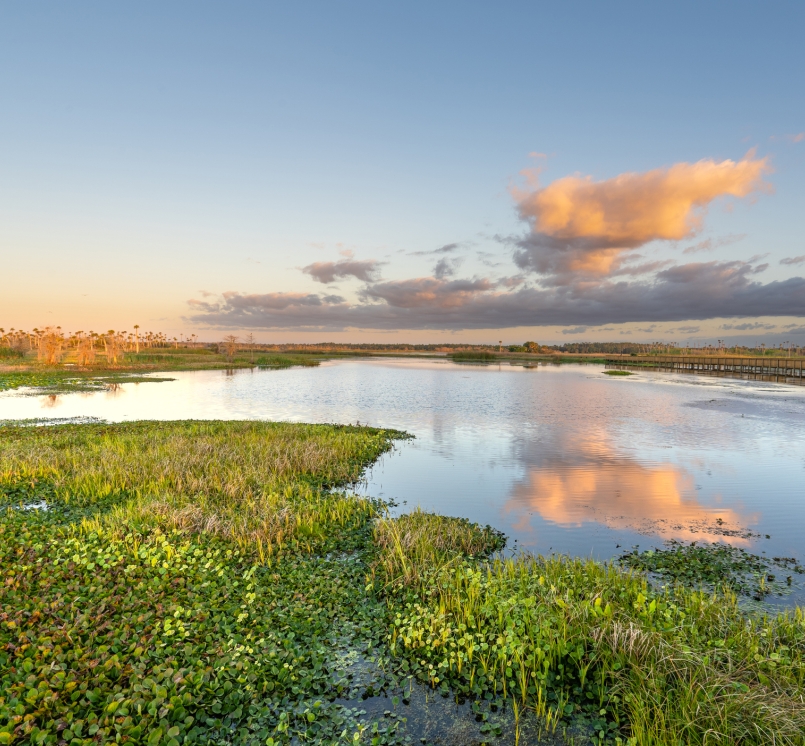Waters of the U.S.
Jump to Section
“Waters of the United States” is a phrase used in the Clean Water Act (CWA) to determine which waters are subject to federal jurisdiction. The CWA establishes the basic governance structure for pollution of the nation’s surface water, prohibiting the discharge of certain pollutants into “navigable waters,” which are defined as “waters of the United States, including the territorial seas.” However, the term waters of the United States, or WOTUS, is not further defined in the CWA. As such, EPA and the Army Corps – the two agencies responsible for administering the CWA – have defined WOTUS in regulations.
The definition of WOTUS directly impacts county governments as owners and operators of local infrastructure. Counties are responsible for public safety water conveyances, municipal separate stormwater sewer systems (MS4), green infrastructure construction and maintenance projects, water reuse infrastructure and emergency management systems. Depending on whether a certain water meets the definition of WOTUS, counties may need to apply for a federal permit to maintain or build new infrastructure projects.
Resource
The Conforming Rule: The Waters of the United States

What Counties Need to Know
For much of the past several decades, regulations written by the EPA and the Army Corps (the agencies) in the 1980s have defined WOTUS. However, in 2015, 2020 and 2023, the agencies made major changes to the definition of WOTUS through the Clean Water Rule, the Navigable Waters Protection Rule (NWPR) and the January 2023 Rule, respectively.
The January 2023 Rule relied on both the “relatively permanent” test and the case-by-case “significant nexus” test to determine whether a water was jurisdictional under the CWA. It additionally extended. As such, elements of the January 2023 rule became invalid following the Supreme Court’s decision in Sackett v. EPA.
In Sackett v. EPA, the Court rejected the “significant nexus” test, finding that CWA jurisdiction extends to “only those relatively permanent, standing or continuously flowing bodies of water ‘forming geographic[al] features’” such as streams, oceans, rivers and lakes. The Court also held that the CWA only applies to wetlands that are WOTUS “in their own right,” meaning those “that are as a practical matter indistinguishable from waters of the United States, such that it is difficult to determine where the water ends and the wetland begins.” Ultimately, the decision in Sackett significantly narrowed the scope of waters subject to federal jurisdiction under the CWA.
Accordingly, EPA and the Army Corps were required to amend the January 2023 Rule to conform with the Sackett decision. The agencies published this ‘conforming’ rule (referred to here as the Final WOTUS Rule) in the Federal Register on September 8, 2023.
To conform with the Supreme Court’s decision in Sackett, the Final WOTUS Rule revises the January 2023 Rule by eliminating references to the “significant nexus” test, amending the definition of “adjacent,” and removing interstate wetlands from the definition of WOTUS. The Final WOTUS Rule is significantly more narrow in scope than the January 2023 Rule, meaning that CWA jurisdiction extends to less county infrastructure than before.
Jurisdictional Categories of WOTUS
The January 2023 Rule | The Final WOTUS Rule | |
|---|---|---|
Jurisdictional Waters | Traditional navigable waters, the territorial seas and interstate waters, including interstate wetlands | Traditional navigable waters, the territorial seas and interstate waters |
Jurisdictional Impoundments | Impoundments of Jurisdictional Waters | Impoundments of Jurisdictional Waters |
Jurisdictional Tributaries | Tributaries of Jurisdictional Waters and Impoundments that meet the relatively permanent test or the significant nexus test | Tributaries of Jurisdictional Waters and Impoundments that meet the relatively permanent” test |
Jurisdictional Wetlands | Wetlands that are 1) adjacent to a Jurisdictional Water; 2) adjacent and with a continuous surface connection to either relatively permanent Jurisdictional Impoundments or Jurisdictional Tributaries that meet the relatively permanent test; or 3) adjacent to Jurisdictional Impoundments or Jurisdictional Tributaries when the wetlands meet the significant nexus test | Wetlands that are 1) adjacent to a Jurisdictional Water; 2) adjacent and with a continuous surface connection to either relatively permanent Jurisdictional Impoundments or Jurisdictional Tributaries that meet the relatively permanent test |
Other Waters | Intrastate lakes and ponds, streams and wetlands not identified above that meet either the relatively permanent test or the significant nexus test | Intrastate lakes and ponds not identified above that meet the relatively permanent test |
Definition of Adjacent
The January 2023 Rule defined “adjacent” as “bordering, contiguous or neighboring.” The January 2023 Rule additionally defined “adjacent wetlands” as those wetlands separated from WOTUS by manmade dikes or barriers, natural river berms, beach dunes and similar barriers.
Under the Final WOTUS Rule, “adjacent” is defined as “having a continuous surface connection.” Notably, however, the Final WOTUS Rule does not define “continuous” or “relatively permanent,” which may mean that the agencies intend to define these terms in future guidance.
Exclusions
The Final WOTUS Rule maintains the list of eight exclusions included under the January 2023 Rule. These exclusions are:
- Prior converted cropland designated by the Secretary of Agriculture. The exclusion would cease upon a change of use, meaning that the area is not available for agricultural production.
- Waste treatment systems, including roadside ditches, excavated wholly in and draining only dry land and that do not carry a relatively permanent flow of water.
- Ditches, including roadside ditches, excavated wholly in and draining only dry land and that do not carry a relatively permanent flow of water.
- Artificially irrigated areas that would revert to dry land if the irrigation ceased.
- Artificial lakes or ponds created by excavating or diking dryland to collect and retain water and which are used exclusively for purposes such as stock water, irrigation, settling basins or rice growing.
- Artificial reflecting pools or swimming pools or other small ornamental bodies of water created by excavating or diking dry land to retain water for primarily aesthetic reasons.
- Waterfilled depressions created in dry land incidental to construction activity and pits excavated in dry land for the purpose of obtaining fill, sand or gravel unless, and until, the construction or excavation operation is abandoned, and the resulting body of water meets the definition of WOTUS.
- Swales and erosional features, such as gullies and small washes, characterized by low volume, infrequent or short duration flow.
Notably, the Final WOTUS Rule does not expand on these exclusions, despite the Court’s finding in Sackett that CWA jurisdiction does not extend to intermittent or ephemeral features. Additionally, provisions around ditches remain quite complicated and the agencies will still have to evaluate the entire reach of the ditch to determine if it has a relatively permanent flow with a reach approach from tributaries.
The Final WOTUS Rule took effect on September 8, 2023. Notably, EPA and the Army Corps did not publish a proposed version of the Rule, meaning that there was no opportunity for public comment. Instead, the agencies relied on the ‘good cause’ exception under the Administrative Procedure Act (APA), which allows for certain exemptions to the required notice and comment period if the agencies find, “for good cause,” that complying with the APA would be “impracticable, unnecessary or contrary to the public interest.”
Given the lack of public comment and the failure to define “relatively permanent” or “continuous,” among other issues, it appears as though the Final WOTUS rule will face legal challenges, which could result in regulatory uncertainty for counties.
It is also possible that Congress could consider passing a joint resolution of disapproval under the Congressional Review Act (CRA) to overturn the Final WOTUS Rule. Congress previously passed a resolution of disapproval under the CRA for the January 2023 Rule, though the resolution was ultimately vetoed by President Biden.
Additionally, because the January 2023 Rule is not in place in 27 states[1], the Final WOTUS Rule is currently only effective in the remaining 23. In those 27 states where the Final WOTUS Rule is not being implemented, the agencies are interpreting the pre-2015 regulatory framework consistent with the Sackett decision. EPA and the Army Corps have issued two coordination memos to the Corps Districts informing district offices of how they should review jurisdictional determinations in the wake of Sackett.
[1] Alabama, Alaska, Arkansas, Florida, Georgia, Idaho, Indiana, Iowa, Kansas, Kentucky, Louisiana, Mississippi, Missouri, Montana, Nebraska, New Hampshire, North Dakota, Ohio, Oklahoma, South Carolina, South Dakota, Tennessee, Texas, Utah, Virginia, West Virginia, Wyoming
